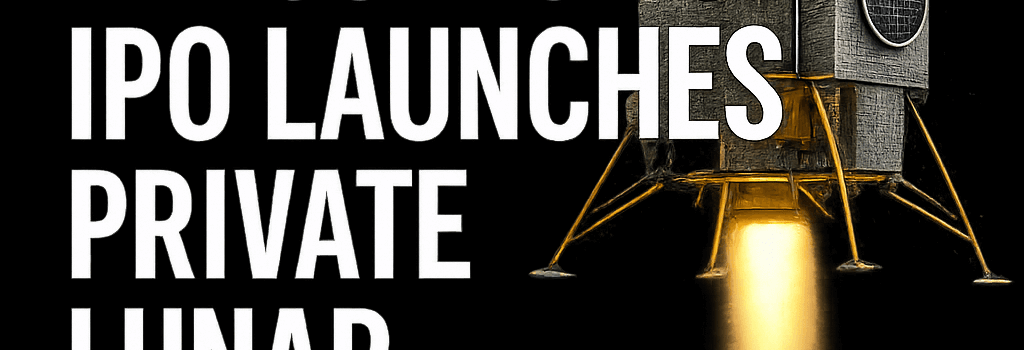Firefly Aerospace’s IPO Launches Private Lunar Lander

Firefly Aerospace, the pioneering private space company that executed the first fully successful commercial lunar landing in March 2025, has filed for an Initial Public Offering (IPO) aiming to raise up to $631.8 million. The proposed offering values the company at near $5.5 billion and marks a crucial step in funding its multi-layered growth strategy across rockets, landers, and in-orbit platforms.
IPO Details and Market Valuation
According to the Form S-1 filed with the SEC on July 28, 2025, Firefly plans to sell 16.2 million shares of common stock at a price range of $35 to $39 per share. The shares are set to trade on the Nasdaq Global Market under the ticker symbol FLY. Proceeds will be allocated to:
- Repaying a substantial tranche of existing debt, including convertible notes and credit facilities;
- Funding ongoing research and development for its new Eclipse medium-lift rocket and the Elytra in-orbit spacecraft family;
- Supporting potential dividend distributions to early investors;
- General corporate purposes such as facility expansion, workforce growth, and supply-chain diversification.
Post-IPO, AE Industrial Partners will retain roughly 42 percent of shares and maintain over 50 percent of voting power, while the offering represents about a 12 percent dilution of existing equity.
Historic Blue Ghost Lunar Mission
On March 2, 2025, Firefly’s Blue Ghost lander became the first privately-owned spacecraft to achieve a fully successful soft landing on the lunar surface. Weighing 1,000 kg at touchdown and powered by four 110-newton hydrazine thrusters, Blue Ghost deployed an array of NASA instruments under a $101.5 million contract:
- Regolith volatile analyzer (ReVA) for in-situ resource characterization;
- Radiation monitoring sensor suite for deep-space environment studies;
- High-resolution stereoscopic camera to map crater morphology;
- Laser retroreflector array for precision Earth-Moon distance measurements.
A down-looking imager captured the lander’s elongated shadow just after lunar sunrise, with Earth rising above the horizon—an iconic confirmation of Firefly’s autonomous guidance, navigation, and control (GNC) software performance. NASA has since awarded Firefly two additional CLPS (Commercial Lunar Payload Services) contracts, each valued at approximately $120 million.
Alpha Rocket Performance and Technical Upgrades
While Blue Ghost succeeded, Firefly’s Alpha small-lift launch vehicle has exhibited a mixed record: six flights since 2021 resulting in two full successes, two partial orbit insertions, and two failures during ascent. The latest sixth flight in April 2025 ended abruptly after stage-separation hardware misalignment damaged the second-stage Reaver engine’s turbopump.
Key specifications of Alpha include:
- Two-stage LOX/RP-1 architecture;
- Stage-1 propulsion via four Lightning engines (each 67 kN thrust);
- Stage-2 single Reaver engine (80 kN thrust) optimized for vacuum;
- Payload capability: 1.1 metric tons to LEO.
In response, Firefly engineers have redesigned the stage-separation ring with additional alignment guides, upgraded avionics redundancy, and introduced improved pyrotechnic separation bolts. A return-to-flight is tentatively scheduled for late Q4 2025, pending final test campaign results.
Development of Eclipse and Elytra Platforms
Beyond Alpha, Firefly is advancing its Eclipse medium-lift rocket in partnership with Northrop Grumman, which invested $50 million in May 2025. Eclipse will feature:
- LOX/liquid methane engines (Miranda engines developing 250 kN thrust each);
- Modular stage segments to carry up to 15 metric tons to LEO;
- Rapid-reusability design with propulsive stage recovery on a landing pad.
Simultaneously, the Elytra in-orbit servicer is undergoing integration tests at Firefly’s Cedar Park, Texas facility. Equipped with an all-electric xenon Hall-effect thruster, Elytra can relocate payloads across different orbits, offering military and commercial customers high-delta-V maneuvering and extended mission durations.
Technical Roadmap and Risk Assessment
Firefly’s technical roadmap through 2027 encompasses:
- Two additional Blue Ghost missions under NASA CLPS;
- Alpha return-to-flight and three commercial rideshare launches;
- Eclipse first static-fire test in Q1 2026, followed by inaugural launch by end of 2026;
- Elytra flight-proven demonstration in low-Earth orbit by mid-2026.
Risk factors include further flight anomalies on Alpha, supply-chain delays for methane engine turbomachinery, and the challenge of scaling up manufacturing capacity amid rising global competition from companies like Rocket Lab, Relativity Space, and SpaceX.
Financial Prospects and Investor Considerations
In 2024, Firefly reported revenues of $60.8 million—up 10 percent year over year—but net losses widened to $231 million, driven by R&D expenses on Eclipse and Elytra. By comparison, Rocket Lab generated $227 million in revenue and a $190 million loss in 2024, yet commands a market cap near $23 billion.
“Near-term profitability is secondary to mission-critical milestones in this industry,” says aerospace analyst Dr. Maria Chen of Orbital Strategies. “Investors are underwriting technical execution and contract backlogs more than quarterly earnings.”
Charles Schwab recently noted a resurgence in IPO activity across sectors, with space companies now favoring traditional public listings over SPAC mergers, following the latter’s post-SPAC devaluations.
Expert Perspectives and Market Implications
Chad Anderson, managing partner of Space Capital, cautions: “90 percent of IPOs that double on day one deliver negative returns over three years. A few, like Rocket Lab, become long-term winners. Most fall short unless they maintain execution discipline and solid financial governance.”
Despite the risks, Firefly’s successful lunar landing, diversified product portfolio, and strategic partnerships position it as a compelling entrant in the public markets. Industry watchers will closely monitor its next Alpha flights, Eclipse milestones, and forthcoming NASA awards under the Artemis program.
Additional Considerations
- Global Competition: European and Asian small-launch startups are accelerating development of methane-fueled vehicles, tightening the competitive landscape.
- Supply-Chain Resilience: Vertical integration of engine component manufacturing could mitigate dependency on single-source suppliers for turbopumps and nozzles.
- Strategic Partnerships: Further MoUs with defense agencies for Elytra-based orbital servicing could unlock recurring revenue streams.